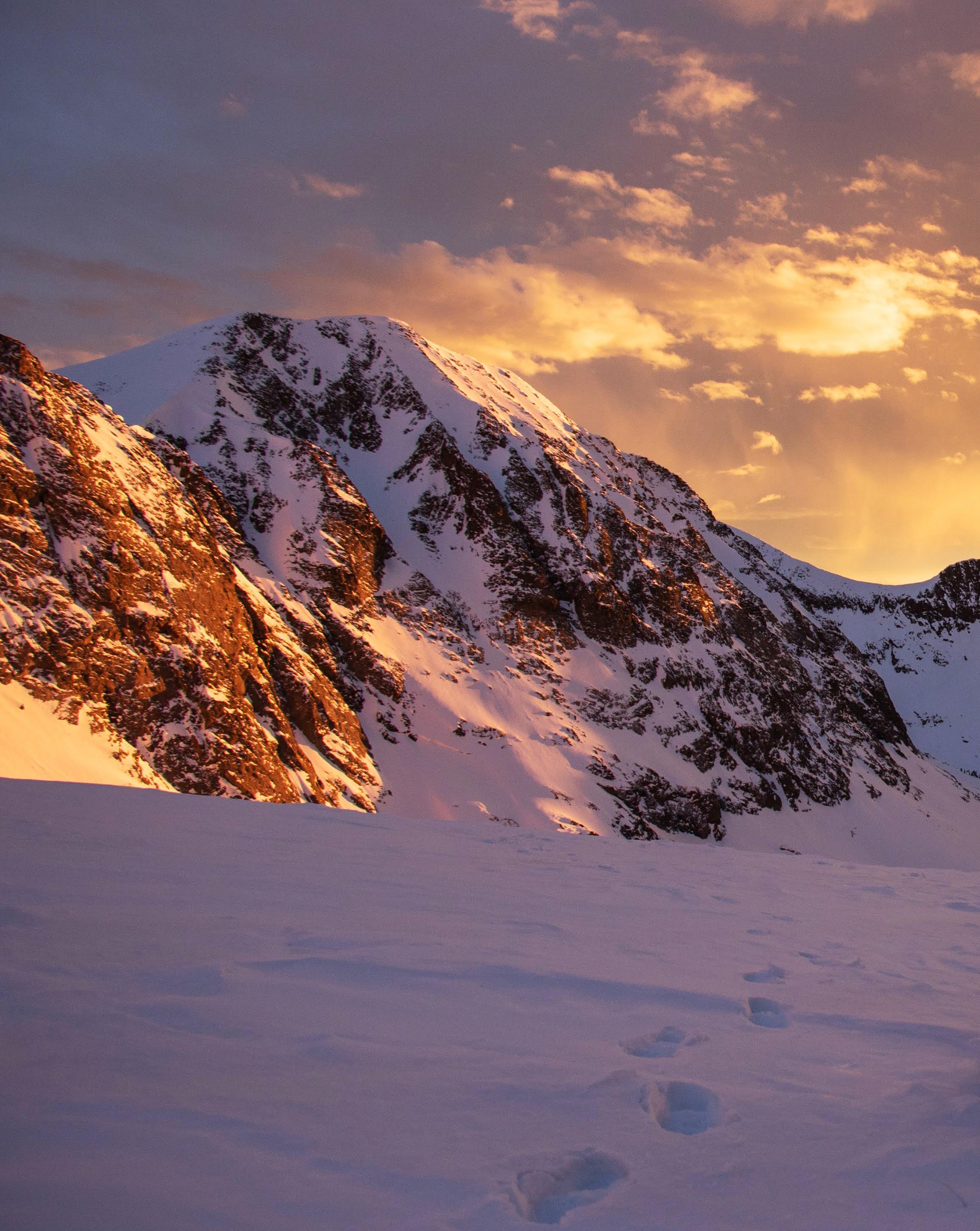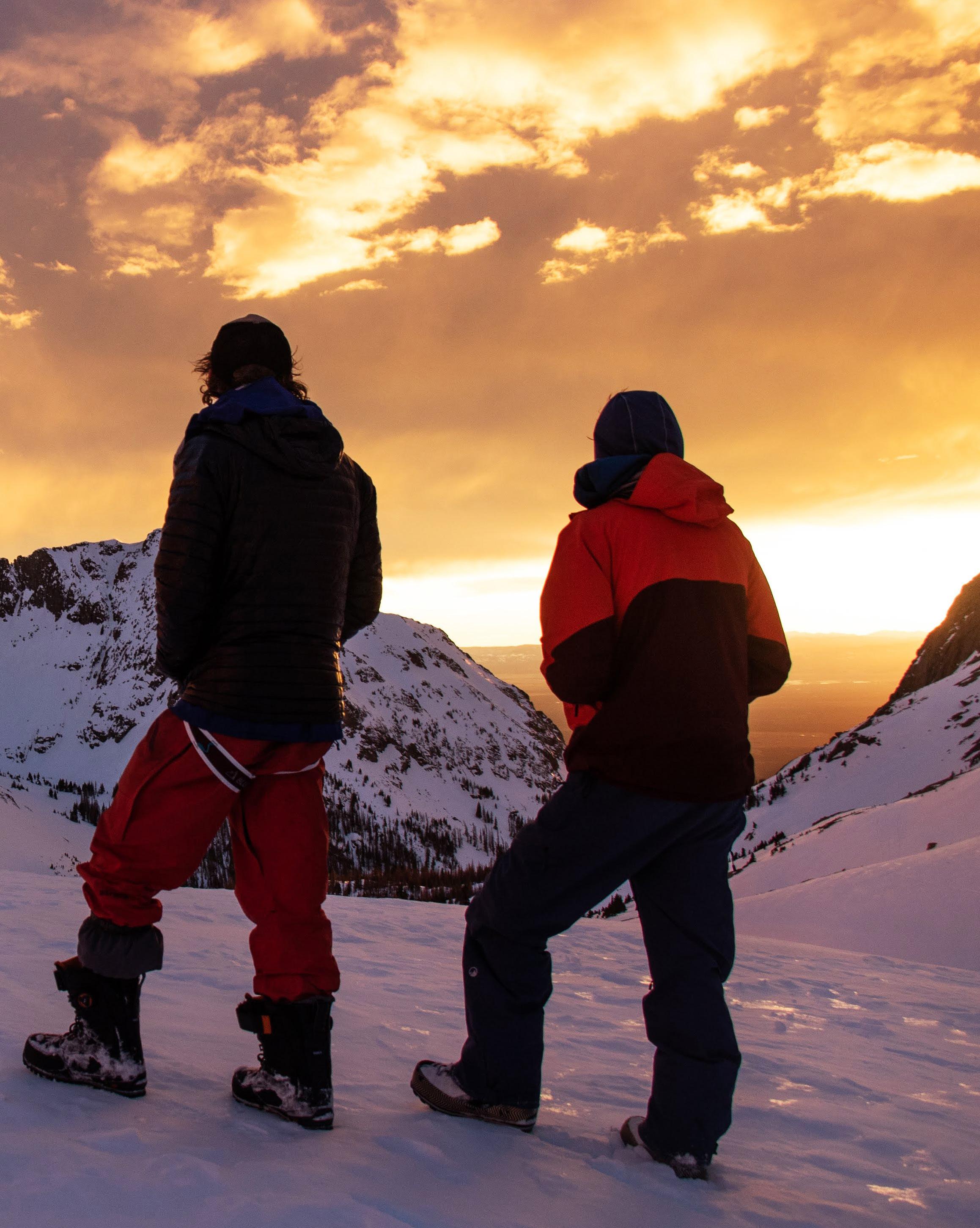
7 minute read
REVIVING RURAL COLORADO
Reviving Rural Regions of Colorado How one man’s mission to ski all of Colorado’s fourteeners revealed distress within small mountain towns
BY JOSH JESPERSEN
The year 2020 has me lost and unsure of where I should go and what I should do. In March, I lost all of my jobs like so many others; and when I wanted to go to the mountains, the only place I truly felt at home, it became socially irresponsible.
The mountains and the natural environment are the only book I can fully read and understand. I have been immersing myself in these austere environments for years, and have even found ways to define purpose in that immersion. During a time fraught with immeasurable uncertainty, where could I look for answers? The only place I could think was where the crowds were screaming not to go. If I couldn’t engage with the wild places to learn my next steps, I would have to examine what they have already taught me: to learn from my past experiences.
BACK TO THE BEGINNING
It was mid-May in 2017 when I finished snowboarding down the sentinel Capitol Peak in the Elk Range of Colorado. This mountain stands proud and venerable in its group of cohorts — Colorado’s 14,000-foot peaks — and is seen as the greatest barrier in any ambitious ski mountaineers quest of descending on snow from the summit of all 54 of these mighty peaks.
After more than 600 miles and over 250,000 feet of vertical descent, I wrapped up my project to become the first person to accomplish this feat in a single ski season. It would take 138 days of in-depth avalanche and weather forecast examination, alpine starts, ice cream induced comas, immobile rest days and a bout of bronchitis to tackle this goal.
Shortly after I finished this project, feeling like I achieved something, a friend of mine and a very accomplished mountaineer in their own right said to me, “Don’t let it be the greatest thing you ever do.” I let that ethos sink in. At that time, I was simultaneously reminiscing about my time traveling around my home state during my fourteeners project and was reminded of the amazing experiences I had been so lucky to have. I realized I had to come up with a way to tell unique stories about what makes our backyard so incredible. How could I persuade people to understand that traveling around the world to feel adventure isn’t necessary?
This yearning to tell these stories came with a self-imposed hitch though — I had to help protect our valuable resources in this effort.
The author and Ricke Schuler stand in awe at a Sangre de Cristo sunset on day 10 of their 13-day ski traverse of that range. photo by Isaiah Branch-Boyle

JOURNEY LINES I’ve skied into the Black Canyon and traversed the Sangre
Now, three years later, I have wrapped up an ambitious ski de Cristo Range. I walked slowly with an elk herd across the project that was formulated from that humbling directive. It took Continental Divide in Rocky Mountain National Park. I put in on the me to the deep and dark corners of our vast Animas River out of Silverton for a packraft/ ranges, where I achieved things I never fully ski expedition that was based around getting thought were attainable, but were worth a shot. I gleaned a deeper understanding of our towns, cultures and ecology. This project, called Journey Lines, is an As more and more towns in our mountains watch their counties’ per capita wealth water samples to improve the watershed and help with mine reclamation efforts. I’ve traveled to Washington D.C. to speak with members of Congress about the CORE Act attempt to share stories of rural Colorado rise due to registered sec- (Colorado Outdoor Recreation Economy) and and ensure that our mountain communities ond homeowners, conse- started a nonprofit that focuses on training who don’t benefit from the winter tourism industry are not relegated to allowing external entities to shape their community. It is imperative that the people living in these vestiges of our mining heritage are not forced to cater to a summer influx of tourists or see only one economic option in extraction. As more and more towns in our mountains watch their counties’ per capita wealth rise due to registered second homeowners, consequently driving the cost of living to unattainable norms, we have to step up instead of rolling over. I never comprehended the changes I would endure during this veterans to be mountain guides and how to work in that economy. During this project, I found myself seeking new types of terrain and different cultural experiences. I loved immersing myself in our vastly different mountain communities across the state. I put myself on a course to explore our mountains in a unique way, and those same mountains have driven me to fight for them and the communities they support. This journey has only made me hungrier than ever, and has stoked the flames to keep looking around the next corner. I don’t think curiosity or wonder have ever been alleviated by embracing it. quently driving the cost of living to unattainable norms, we have to step up instead of rolling over. project, the leaps I would take in life over that time and the new THE NEXT MOVE perspective I would offer myself. I didn’t know that engaging on a The personal uncertainty of moving forward in 2020 is beginning deeper level with these places would show me how much more to beat a maddening drum that is growing louder and louder. My there was to explore. restless soul is yearning to continue to look around the corner and
Touring in bad weather is at times enticing, yet dangerous. photo by Isaiah Branch-Boyle

see what’s there, but I cannot decide what corner to look around. I have been aimlessly wandering all summer with no clear defined path into winter. But as the first snowfall of the season coats the seas of mountains we live in, it acts as a prism, turning the dull monocolor autumn light into a vibrant rainbow — calming me. When the snow falls, our mountains become quiet again; standing deserted and wild, untamed and barren, intimidating and alluring. This is when they truly open up and come alive. This is our place, and where we need to be. When I reflect on the time I spend up high, subconsciously seeking personal revelation, I always come back to the people. I always think back to the unique characters that live in the nooks and crannies of society during the summer only to go outside and thrive like me in the winter. I always think back to our community in this state, and how we need to keep fighting together, to make sure we have a say in our future. Because in the end, the only thing we can control is ourselves and the effort we put forth in directing our destiny. So that’s where I find my grounding and my focus: in us — in our state and our community, fighting for rural Colorado and rural America by compelling you and others to learn how to appreciate our own backyard. So much that you are willing to advocate for both the land and yourself.
JOSH JESPERSEN is the author of the upcoming adventure guidebook, Journey Lines , which is all based on out of the box adventures in rural Colorado. Josh is the cofounder of Veteran’s Outdoor Advocacy Group and considers himself an advocate for veterans, conservation and rural America. If you are interested in avalanche education this winter, book a course with Josh at Silverton Avalanche School.
The author and the Journey Lines crew made a foray into an unknown spot to ski new lines, but instead found new perspectives. photo by Isaiah Branch-Boyle

WHAT YOU CAN DO
Protect Our Winters (POW) is a supporter of the CORE Act, and provides Jespersen with a platform to advocate for the passing of this bill. The CORE Act will “protect 400,000 acres of public land in Colorado, establishing new wilderness areas and safeguarding existing outdoor recreation opportunities,” according to POW’s website.
While the bill has passed the House of Representatives, there is still work to do. The bill still needs to pass the Senate.
Support the cause: • Educate yourself on the CORE Act • Talk to your friends and family about the CORE Act • Text COREACT to 52886 to contact your members of Congress • Donate to Protect Our Winters • Sign up to volunteer with Protect Our Winters

The first descent team of ‘Bang the Gong’ rappels through the massive cliff at the bottom of the incredibly aesthetic full north face of Mount Antero. photo by Isaiah Branch-Boyle










